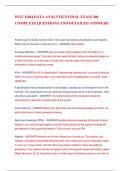Exam (elaborations)
WGU D204 DATA ANALYTICS FINAL EXAM 200 COMPLETE QUESTIONS AND DETAILED ANSWERS.
- Course
- Institution
WGU D204 DATA ANALYTICS FINAL EXAM 200 COMPLETE QUESTIONS AND DETAILED ANSWERS. Andre is part of a data science team. He is good at creating visualizations and reports. Which role on the team is best for him? – ANSWER data analyst Anomaly detection – ANSWER tese are cases that are dista...
[Show more]



